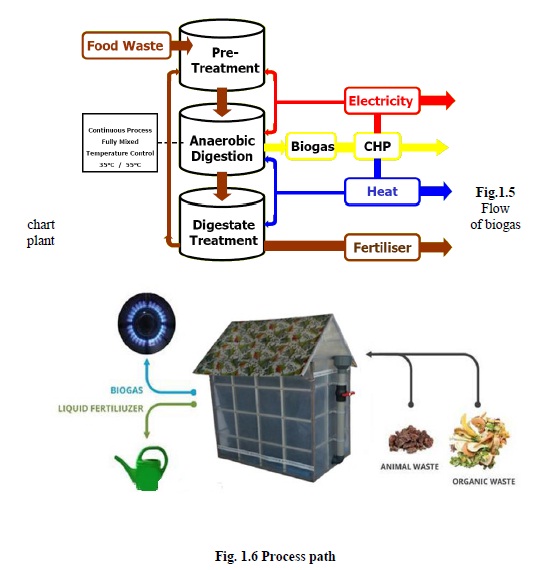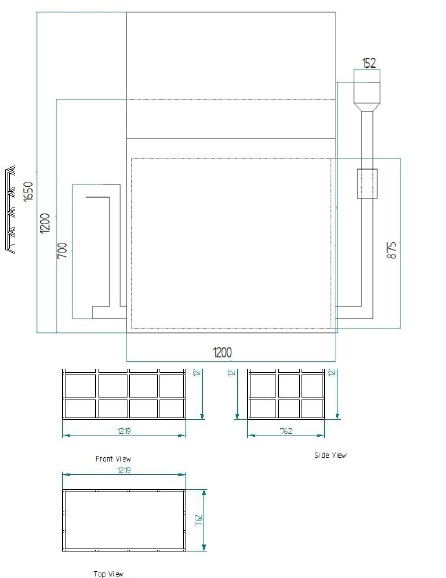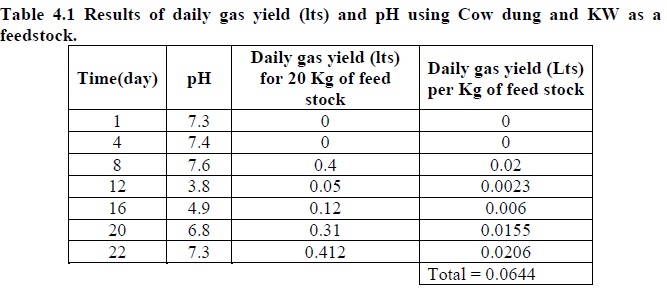





Published on Nov 30, 2023
The scarcity of petroleum threatens the world‟s fuel supply. The fact is that the Biogas Methane can be successfully employed to overcome this threat has given rise to various Biogas producing practices. The conventional Biogas plants of cattle dung, distillery effluent(Spent Wash), municipal solid wastes or sewage are employed to overcome these threats. But these plants are inefficient because of lower calorific value of biogas & lesser methane generation. An important fact that one has to be noted that a lot of kitchen waste which has ability to produce Biogas other than cow dung or animal waste is not utilized in a proper way. The main objective of our project is to set up an experiment for bio gas generation by using various kitchen wastes as feed stocks. These household digesters represent a boon for farmers and rural people to meet their energy needs. These digesters help in two ways: one is to reduce waste, and the other is to provide valuable energy. Although they have been used for many years, modernization is needed to overcome the drawbacks in the long run. The awareness by people of their technical issues, and governmental subsidy plans could provide even more benefits from household digesters.
Biogas is produced by bacteria through the bio-degradation of organic material under anaerobic conditions. Natural generation of biogas is an important part of bio-geochemical carbon cycle. It can be used both in rural and urban areas. Due to scarcity of petroleum and coal it threatens supply of fuel throughout the world also problem of their combustion leds to research in different corners to get access the new sources of energy, like renewable energy resources. Solar energy, wind energy, different thermal and hydro sources of energy, biogas are all renewable energy resources. But, biogas is distinct from other renewable energies because of its characteristics of using, controlling and collecting organic wastes and at the same time producing fertilizer and water for use in agricultural irrigation.
Biogas does not have any geographical limitations nor does it requires advanced technology for producing energy, also it is very simple to use and apply. Deforestation is a very big problem in developing countries like India, most of the part depends on charcoal and fuel-wood for fuel supply which requires cutting of forest. Also, due to deforestation It leads to decrease the fertility of land by soil erosion. Use of dung , firewood as energy is also harmful for the health of the masses due to the smoke arising from them causing air pollution. We need an ecofriendly substitute for energy.
Kitchen waste is organic material having the high calorific value and nutritive value to microbes, that‟s why efficiency of methane production can be increased by several orders of magnitude as said earlier. It means higher efficiency and size of reactor and cost of biogas production is reduced. Also in most of cities and places, kitchen waste is disposed in landfill or discarded which causes the public health hazards and diseases like malaria, cholera, typhoid. Inadequate management of wastes like uncontrolled dumping bears several adverse consequences It not only leads to polluting surface and groundwater through leachate and further promotes the breeding of flies, mosquitoes, rats and other disease bearing vectors.
Also, it emits unpleasant odour & methane which is a major greenhouse gas contributing to global warming. Composting technology is currently applied as the most popular means to recycle organic waste into bio-fertilizer. However, due to the lack of market support, bio-fertilizer quality assurance, and the high cost of solid fertilizer transport, the composting technology shows insignificant progress . A new alternative is now being explored consisting of converting organic waste, such as food waste, into biogas using bio-digesters. A bio-digester is built to provide a completely or almost anaerobic condition for some specific bacteria to grow and eventually digest the organic waste. This alternative is considered more beneficial, because in addition to the production of liquid bio-slurry used for fertilizer it also yields biogas as an energy source, which can substitute the commonly used Liquid Petroleum Gas
The main objective of this Project proposal is to:
Fabricate Family size biogas plant to produce methane and fertilizer from Kitchen waste & any other organic waste(Plant leaf, Waste fruits).
This biogas plant can be taken to any place to avoid handling of kitchen waste to the plant.
This project employs anaerobic digestion process as a sustainable technology for minimizing the organic fraction of kitchen solid waste going to landfill and to provide the renewable source of energy as well as to reduce the potential greenhouse gases emission from landfill.
Biogas is useful as a substitute for firewood, dung, agricultural residue, petrol, diesel and electricity. The kitchen wastes and vegetable wastes like rice and posho, bakery waste, vegetables and raw leafy vegetables like cabbage leaves, fruit peelings like sweet banana, banana and papaya, etc, was discarded and found to be useless and unwanted one in college hostels and canteen. These wastes were disposed with municipal solid wastes. An attempt can be made to use such a wastes effectively so as to get an eco friendly fuel which can be used for kitchen purposes in college hostels and canteen. The kitchen wastes are used as inputs for the plant and the residue which is called as digestate that remains in the digester is used as a manure and in some agricultural purposes. The Kitchen Waste Biogas Plant is constructed near college hostel and canteen premises which provides sufficient amount of fuel for the kitchen purposes.


The project idea begins with the questions e.g., if a biogas plant will fit into the smart city and green city concept, will the project be helpful to enhance the farm in its development and what information‟s are needed to answer these questions and to develop a precise project idea. This first step of the project embraces all the basic questions the food waste should have during his first reflection to decide, if he wants to go on planning a portable biogas project. As it is the first step of action, mainly general data collection, qualitative assessments and rough quantitative calculations can be done by the our project mates. When considering a biogas project, it is important to see the whole picture, including the availability of substrate, the actual biogas plant and the supply of energy to purchasers. The objective being to carry out a well-founded initial evaluation of the project concept. The person has to care about subjects like the availability of substrates for biogas use and the options for transport and storage, first settings on plant type and on categories of production capacity on the options for energy use so as information on plant location and implementation into the existing farm.

A balloon plant consists of a heat-sealed PVC Fabric material bag (balloon), combining digester and gas-holder. The gas is stored in the upper part of the balloon. The inlet and outlet are attached directly to the skin of the balloon. Gas pressure can be increased by placing weights on the balloon. If the gas pressure exceeds a limit that the balloon can withstand, it may damage the skin. Therefore, safety valves are required. If higher gas pressures are needed, a gas pump is required. Since the material has to be weather- and UV resistant, specially stabilized, reinforced plastic or synthetic caoutchouc is given preference. Other materials which have been used successfully include PVC Fabric material. The useful life-span does usually not exceed 2-5 years. A variation of the balloon plant is the channel-type digester, which is usually covered with plastic sheeting and a sunshade. Balloon plants can be recommended wherever the balloon skin is not likely to be damaged and where the temperature is even and high.

It is used to pour the kitchen waste and water mixture into the Digester tank. It is fixed to bottom of the Digester tank. The pipe which is inserted should be extended upto the middle portion of the Digester to distribute the slurry properly in the Digester tank. It is assembled by Reducer collar, PVC pipe, T-collar, Male threaded adopter (MTA) collar, Female threaded adopter (FTA) collars, threaded end cap and washers.
We disassembled an old water softener system We got for free and ended up with a good amount of semi-rigid plastic tubing, fittings, and a valve that I figured would be perfect for the biogas outlet. Drilled another hole for the valve and threaded the adapter into it, then ran the line to another valve that will then connect to the collector. Note the T fitting in the middle. That's acting as a placeholder for a sulfur scrubber that we intend to build later down the line. Biogas digesters produce plenty of methane, some CO2, and enough hydrogen sulfide to make the biogas stink. The sulfur isn't all that useful for us, so it'll be worth scrubbing out of the end product. Which my neighbors should appreciate. As for the different-sized tubing, that's just a result of using what we had on hand. The larger tubing measures 3/8 inch and fits perfectly into compression fittings
The overflow tube goes toward the top using 3/4-inch PVC pipe and fittings. To keep the digester sealed, We added a valve (for when the fluid level hasn't yet reached the overflow tube) and a J-bend (for when it has). This will just dump out to a 5-gallon bucket for now, but I may add an overflow tank later on. Note the upturned entrance to the overflow tube inside the digester. This ensures that only fluid will enter the tube and that the system doesn't airlock.
A gas outlet port is a metallic enclosure which is used to provide local exhaust ventilation system for virtually all of the gases used or generated to connect through gas stove. The primary purpose of gas outlet port is to contain potential leaks in piping and fittings at the cylinder connection. The outlet port must be exhausted by a specifically designed fan and exhaust system. In the case of a flammable gas outlet port will contain the flame for a period of time. One can use a newly reconditioned outlet port as well as non-reconditioned used gas outlet port depending on their requirements. Since the carbon fraction is changed by the fermentation of substrates, in essence the nutrients remain unchanged.
The nutrients in the digestate are more soluble and therefore more available to plants after the anaerobic digestion process .In addition, the digestate also carries a certain value, which can be calculated on the basis of current fertilizer prices. The value of 1 m³ manure digestate is (country specific) about 721.5 ₨ per ton. Related to the value is also the transportability. At a distance of more than approx. 18 km the transport costs for digestate exceed the price for mineral fertilisers and transport is no longer feasible in economic terms.
The Cow dung, kitchen waste in the form of rice and posho, Fruit peelings like vegetables and raw leaf vegetables like tomato, cucumber, green chilies, radish leaves and cabbage leaves and raw vegetable peelings like sweet potato and potato are fed in this Kitchen Waste biogas plant. The parameters like pH, gas yields per day is tabulated and graphs are drawn

Four kg of cow dung is thoroughly mixed with 8 ltrs of water and mixture is added to the digester tank daily and will be left for digestion. On the 3rd day, fermentation starts in the tank and a maximum amount of gas is generated on that day. This gas will be collected in the gas collecting bladder. From next day onwards continuously a smaller amount of gas production will be found in the plant. Once the gas formation starts continuously, the cow dung in 1:2 ratio (i.e. 4 kg of cow dung and 8 ltrs of water) will beregularly fed with a retention time of 19 days. Everyday pH, amount of gas accumulated
Due to the time restriction an extensive study was not possible regarding the generation of biogas from various other feedstock‟s therefore, there is a scope for further detailed studies which includes
o Effect of gas generation for different ratios of feedstock.
o Comparative study on other types of biodegradable wastes.
The following conclusions may be drawn based on the results obtained:
It was found that biogas was successfully generated even in a low temperature climate from the following feedstock
Kitchen Waste: Cooked food ( rice and posho), Fruit peelings(sweet banana ) Vegetables, Raw leafy vegetable:(Tomato, cucumber, green chilly, radish leaves, cabbage leaves).
Since a greater quantity of vegetable waste and food waste is produced in hostel, inspite of disposing it in a dumping area, it can be degenerated by biogas generation.
Dumping of kitchen waste in a open area leads to breeding of unwanted bacteria‟s and insects which reduces quality of human inhabitation.
Biogas so generated can be used as a fuel for cooking purposes and if generated in large quantities it can be used to generate power.
Sludge that is removed periodically acts as good organic manure, which has high quality of fertilizing soil.
1. P.A.Gadge, Dr.A.C.Waghmare, V.R.Ninave. “Bio Gas Generation Plant Based On Kitchen Waste Material” Vol.-8, No.-3, Feb. 2014 [IJETT]
2. G.R.K.D.Satya Prasad, Sarat Kumar SahooSambitPritam, ShyamaSundarmarandi, Amith Kumar. “Kitchen Waste Based Biomass Plant For Power Generation” Vol.-3, Issue-4, Apr. 2016 [IJETT]
3. Sunil MP, Ashik Narayan, VidyasagarBhat, Vinay S. “Smart Biogas Plant” Vol.-3, Issue-3, Aug 2013 [IJITEE]
4. Nabila Laskri and NawelNedjah. “Comparative Study For Biogas Production From Different Wastes” Vol.-7, No.-4, (2015) [IJBSBT]